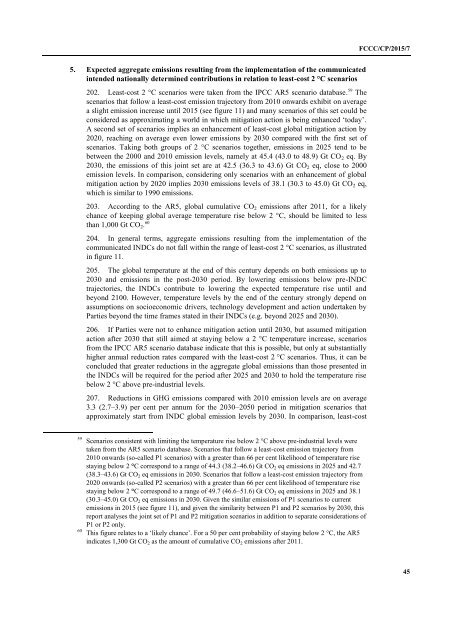FCCC/CP/2015/7
1PYuHQM
1PYuHQM
Create successful ePaper yourself
Turn your PDF publications into a flip-book with our unique Google optimized e-Paper software.
<strong>FCCC</strong>/<strong>CP</strong>/<strong>2015</strong>/7<br />
5. Expected aggregate emissions resulting from the implementation of the communicated<br />
intended nationally determined contributions in relation to least-cost 2 °C scenarios<br />
202. Least-cost 2 °C scenarios were taken from the IPCC AR5 scenario database. 59 The<br />
scenarios that follow a least-cost emission trajectory from 2010 onwards exhibit on average<br />
a slight emission increase until <strong>2015</strong> (see figure 11) and many scenarios of this set could be<br />
considered as approximating a world in which mitigation action is being enhanced ‘today’.<br />
A second set of scenarios implies an enhancement of least-cost global mitigation action by<br />
2020, reaching on average even lower emissions by 2030 compared with the first set of<br />
scenarios. Taking both groups of 2 °C scenarios together, emissions in 2025 tend to be<br />
between the 2000 and 2010 emission levels, namely at 45.4 (43.0 to 48.9) Gt CO 2 eq. By<br />
2030, the emissions of this joint set are at 42.5 (36.3 to 43.6) Gt CO 2 eq, close to 2000<br />
emission levels. In comparison, considering only scenarios with an enhancement of global<br />
mitigation action by 2020 implies 2030 emissions levels of 38.1 (30.3 to 45.0) Gt CO 2 eq,<br />
which is similar to 1990 emissions.<br />
203. According to the AR5, global cumulative CO 2 emissions after 2011, for a likely<br />
chance of keeping global average temperature rise below 2 °C, should be limited to less<br />
than 1,000 Gt CO 2 . 60<br />
204. In general terms, aggregate emissions resulting from the implementation of the<br />
communicated INDCs do not fall within the range of least-cost 2 °C scenarios, as illustrated<br />
in figure 11.<br />
205. The global temperature at the end of this century depends on both emissions up to<br />
2030 and emissions in the post-2030 period. By lowering emissions below pre-INDC<br />
trajectories, the INDCs contribute to lowering the expected temperature rise until and<br />
beyond 2100. However, temperature levels by the end of the century strongly depend on<br />
assumptions on socioeconomic drivers, technology development and action undertaken by<br />
Parties beyond the time frames stated in their INDCs (e.g. beyond 2025 and 2030).<br />
206. If Parties were not to enhance mitigation action until 2030, but assumed mitigation<br />
action after 2030 that still aimed at staying below a 2 °C temperature increase, scenarios<br />
from the IPCC AR5 scenario database indicate that this is possible, but only at substantially<br />
higher annual reduction rates compared with the least-cost 2 °C scenarios. Thus, it can be<br />
concluded that greater reductions in the aggregate global emissions than those presented in<br />
the INDCs will be required for the period after 2025 and 2030 to hold the temperature rise<br />
below 2 °C above pre-industrial levels.<br />
207. Reductions in GHG emissions compared with 2010 emission levels are on average<br />
3.3 (2.7–3.9) per cent per annum for the 2030–2050 period in mitigation scenarios that<br />
approximately start from INDC global emission levels by 2030. In comparison, least-cost<br />
59 Scenarios consistent with limiting the temperature rise below 2 °C above pre-industrial levels were<br />
taken from the AR5 scenario database. Scenarios that follow a least-cost emission trajectory from<br />
2010 onwards (so-called P1 scenarios) with a greater than 66 per cent likelihood of temperature rise<br />
staying below 2 °C correspond to a range of 44.3 (38.2–46.6) Gt CO 2 eq emissions in 2025 and 42.7<br />
(38.3–43.6) Gt CO 2 eq emissions in 2030. Scenarios that follow a least-cost emission trajectory from<br />
2020 onwards (so-called P2 scenarios) with a greater than 66 per cent likelihood of temperature rise<br />
staying below 2 °C correspond to a range of 49.7 (46.6–51.6) Gt CO 2 eq emissions in 2025 and 38.1<br />
(30.3–45.0) Gt CO 2 eq emissions in 2030. Given the similar emissions of P1 scenarios to current<br />
emissions in <strong>2015</strong> (see figure 11), and given the similarity between P1 and P2 scenarios by 2030, this<br />
report analyses the joint set of P1 and P2 mitigation scenarios in addition to separate considerations of<br />
P1 or P2 only.<br />
60 This figure relates to a ‘likely chance’. For a 50 per cent probability of staying below 2 °C, the AR5<br />
indicates 1,300 Gt CO 2 as the amount of cumulative CO 2 emissions after 2011.<br />
45


